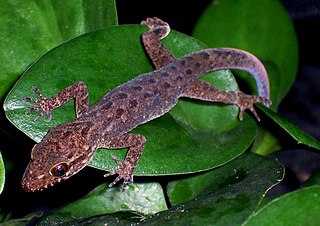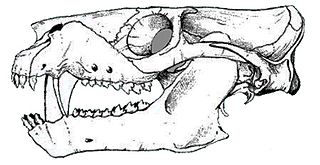
Cyprinidae is a family of freshwater fish commonly called the carp or minnow family. It includes the carps, the true minnows, and relatives like the barbs and barbels. Cyprinidae is the largest and most diverse fish family and the largest vertebrate animal family in general with about 3,000 species, of which only 1,270 remain extant, divided into about 370 genera. Cyprinids range from about 12 mm in size to the 3-m giant barb. By genus and species count, the family makes up more than two-thirds of the ostariophysian order Cypriniformes. The family name is derived from the Greek word kyprînos.

Cyrtodactylus is a diverse genus of Asian geckos, commonly known as bent-toed geckos, bow-fingered geckos, and forest geckos. The genus has at least 300 described species as of 2020, which makes it the largest of all gecko genera.

Dryinidae is a cosmopolitan family of solitary wasps. Its name comes from the Greek drys for oak: Latreille named the type genus Dryinus because the first species was collected in an oak plant in Spain. The larvae are parasitoids of the nymphs and adults of Auchenorrhyncha. Dryinidae comprises approximately 1900 described species, distributed in 17 subfamilies and 53 genera.

The straight-tooth weasel shark, Paragaleus tengi, is a weasel shark of the family Hemigaleidae, found in the tropical western Pacific Ocean. It can reach a length of 88 cm.

Scythrididae is a family of small moths in the superfamily Gelechioidea. The family is sometimes included in the Xyloryctidae as a subfamily Scythridinae, but the Xyloryctidae themselves have sometimes been included in the Oecophoridae as subfamily. Scythrididae adults are smallish to mid-sized moths, which when at rest appear teardrop-shaped.
The Gobi big brown bat is a species of vesper bat. It is found in Afghanistan, China, India, Mongolia, Pakistan, and Russia. Russian zoologist Professor Count Nikolay Alekseyevich Bobrinski first described it in 1926, the type specimen coming from the Altai Mountains in the Gobi Desert.

The buff-crested bustard is a medium-sized bird of East Africa belonging to the family Otididae. The populations are stable and the species is of least concern.

The bayad, is a species of bagrid catfish from Africa.

Taddei's serotine is a species of medium-sized bat belonging to the family Vespertilionidae. It is restricted to the Atlantic Forest of southern Brazil.

Lamprologini is a tribe of African cichlid fishes. It contains seven genera and nearly 100 species. Over half of the species in this tribe are in the large genus Neolamprologus. Most genera in the tribe are endemic to Lake Tanganyika, but one species of Neolamprologus is from the Malagarasi River in Tanzania, and several species of Lamprologus are from the Congo River Basin.
Talpanas lippa, the Kauaʻi mole duck, is an extinct species of duck. It was first described by Andrew N. Iwaniuk, Storrs L. Olson, and Helen F. James in the journal Zootaxa in November 2009. It is the only known member of the genus Talpanas. It was endemic to the Hawaiian island of Kauai where the fossil remains were unearthed in the Makauwahi Cave, Maha‘ulepu. The archaeological association of the bones is about 6000 years BP.
Crocidura phanluongi is a species of shrew in the genus Crocidura from southern Vietnam and nearby Cambodia. It is a somewhat small, gray shrew with an ecologically diverse distribution.

Trucidocynodon is an extinct genus of ecteniniid cynodonts from Upper Triassic of Brazil. It contains a single species, Trucidocynodon riograndensis. Fossils of Trucidocynodon were discovered in Santa Maria Formation outcrops in Paleorrota geopark Agudo. T. riograndensis was similar to Ecteninion lunensis from the Upper Triassic Ischigualasto formation of Argentina, but differed in several respects, including its larger size. It is known from a nearly complete holotype skeleton as well as a referred skull. The holotype skeleton had an estimated length of 1.2 meters, while the referred skull was 17% larger than that of the holotype. Trucidocynodon is considered one of the largest known carnivorous cynodonts from the Triassic, as well as one of the largest probainognathians in the entire Mesozoic.
The Overberg velvet worm is a species of velvet worm in the Peripatopsidae family. This species usually has 19 pairs of legs: 18 pregenital leg pairs plus one last pair that is strongly reduced and without claws or spinous pads. Some specimens, however, have only 18 leg pairs. This species is limited to the Overberg region of South Africa.

The long-toothed pipistrelle is a species of bat of the genus Hypsugo. It is a small bat, with a length of 35.2–38.4 mm of forearm, and 5.9–7 mm of foot. It feeds on insects and has especially long canines compared to others of its genus.

Arrudatitan is an extinct genus of titanosaur sauropod dinosaur known from the Late Cretaceous (Campanian-Maastrichtian)-aged Adamantina Formation of Brazil. The type species, A. maximus, was named and described in 2011 as a species of Aeolosaurus, but was separated into its own genus in 2021. It was relatively gracile for a titanosaur.

Phasma gigas is a large-sized stick insect found in Maluku Islands, Sulawesi, Gorong Islands and Kei Islands. It is often believed that Phasma gigas is present on New Guinea, but in fact, all New Guinean records actually refer to Phasma reinwardtii. Furthermore, the historic records from Sulawesi are doubtful and need more evaluation.
Anchiale buruense is a medium-sized stick insect found in Buru of the Maluku Islands, Indonesia.
Anchiale maculata is a medium-sized stick insect found on the Maluku Islands, Peleng Island and Kei Islands. Anchiale maculata was first described by Oliver in 1792 as Mantis maculata. The genus Anchiale was introduced by Stål (1875) with the type species Anchiale maculata.
Anchiale simplex is a medium-sized stick insect. The existence of this species is questionable. It was described from a single female from French Polynesia in the Museum of Natural History of Vienna, but close examination by entomologist, Frank Hennemann, of the holotype in the Museo Civico di Storia Naturale revealed this species to be too similar to Anchiale stolli from the Bismarck Archipelago and Solomon Islands. Further research is needed.












